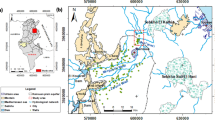Abstract
Due to a humid climate, karst areas in south China have an abundance of groundwater. With the development of agriculture, industry, and mining, the potential factors that may result in catastrophic groundwater pollutions are increasing. A phosphorus groundwater pollution event and its subsequent emergency treatment at Penshuidong Cave in Songming, Yunnan Province on February 24, 2008 were analyzed in addition to water quality monitoring in the region. The results showed that concentrations of phosphates, fluoride, cyanides and volatile phenols in phosphorus sludge waste liquid to be 11,532, 252, 224, 200 times higher than that of the Environmental quality standards for surface water (GB 3838-2002) III, respectively. The element phosphorus concentration was 16,510 times higher than the limit set by the Water quality standard for fisheries (GB11607-1989). The addition of quicklime and water to the phosphorus sludge waste liquid dumping pit clearly decreased pollutant concentrations, which indicates that the quicklime can remove the phosphorus from the waste liquid. Peak values of pollutant concentration decreased along the flow direction, which suggests the highly concentrated polluted water mass may be diluted during its movement. After treatment with water, a pollutant concentration peak appears at the groundwater outlet indicating that washing may accelerate the moving speed of the pollutants in groundwater. Element phosphorus concentrations, however, remained at a high and stable range(46–65 times higher than the limit set by the Water quality standard for fisheries).



Similar content being viewed by others
References
Beach T, Beach SL, Dunning N et al (2008) Human and natural impacts on fluvial and karst depressions of the Maya Lowlands. Geomorphology 101(1–2):308–331. doi:10.1016/j.geomorph.2008.05.019
Calò F, Parise M (2008) Waste management and problems of groundwater pollution in karst environments in the context of a post-conflict scenario: the case of Mostar (Bosnia Herzegovina). Habitat Int. doi:10.1016/j.habitatint.2008.05.001
Canora F, Fidelibus MD, Sciortino A et al (2008) Variation of infiltration rate through karstic surfaces due to land use changes: a case study in Murgia (SE-Italy). Eng Geol 99(3–4):210–227. doi:10.1016/j.enggeo.2007.11.018
Department of Water Resources Management, Ministry of Water Resources of China, Nanjing Hydraulic Research Insititute (2004) Groundwater resources development and utilization in china in the early 21st century, vol 1. China WaterPower Press (in Chinese)
Ducci D, Masi GD, Priscoli GD (2008) Contamination risk of the Alburni Karst System (southern Italy). Eng Geol 99(3–4):109–120. doi:10.1016/j.enggeo.2007.11.008
Jiang JJ (2007) Pollution and countermeasures of groundwater in China. Environ Prot 19:16–17 (in Chinese with English abstract)
Jong CD, Cappy S, Finckh M et al (2008) A transdisciplinary analysis of water problems in the mountainous karst areas of Morocco. Eng Geol 99(3–4):228–238. doi:10.1016/j.enggeo.2007.11.021
Lang YC, Liu CQ, Zhao ZQ (2005) Chemical compositions of surface and ground water of Guiyang city: discussion of water-rock interaction and contamination in karstic hydrological system. Adv Water Sci 16(6):826–832 (in Chinese with English abstract)
Parise M, Waele JD, Gutierrez F (2008) Engineering and environmental problems in karst—an introduction. Eng Geol 99(3–4):91–94. doi:10.1016/j.enggeo.2007.11.009
Wan GJ (2000) Carbonate and the environment, vol 2. Earthquake Publishing House (in Chinese)
Wang LC, Shi YL (2006) Formation process and rational use of water resources and transform of rainfall, surface water and underground water in karst mountainous area in Southwest China. Scientia Geographica Sinica 26(2):173–178 (in Chinese with English abstract)
Yang ST, Wang B, Wang YJ (2007) Trend and state of RS monitoring of soil and water loss in karst region. Bull Soil Water Conserv 27(1):62–66 (in Chinese with English abstract)
Yuan DX (1993) Karstology in China. Geological Publishing House, Beijing (in Chinese)
Acknowledgments
This work was funded by the Geography key discipline construction project of Yunnan Province, the Science and Technology Project of Yunnan Bureau of Hydrology and Water Resources (2008) and Project of young and middle-aged leaders of academic and technology of Yunnan (2007py01-43). Many thanks to Prof. Dawson R. W. for his work on the manuscript. The authors also thank the anonymous reviewers for their constructive comments on an earlier draft of the paper.
Author information
Authors and Affiliations
Corresponding author
Rights and permissions
About this article
Cite this article
Shi, Z., Liu, X., Liu, Y. et al. Catastrophic groundwater pollution in a karst environment: a study of phosphorus sludge waste liquid pollution at the Penshuidong Cave in Yunnan, China. Environ Earth Sci 59, 757–763 (2009). https://doi.org/10.1007/s12665-009-0071-z
Received:
Accepted:
Published:
Issue Date:
DOI: https://doi.org/10.1007/s12665-009-0071-z




